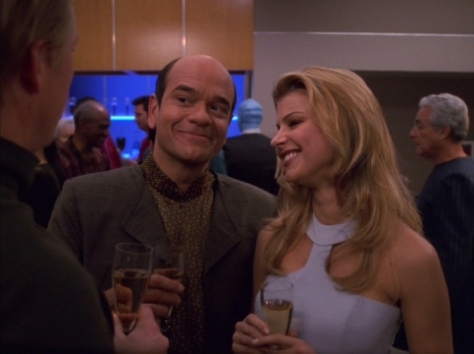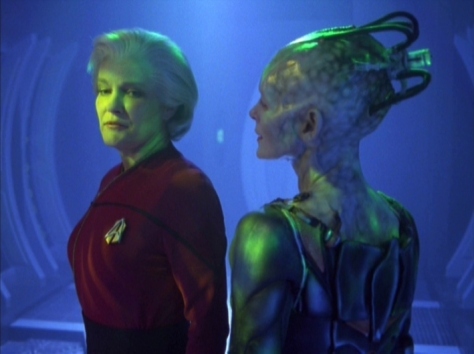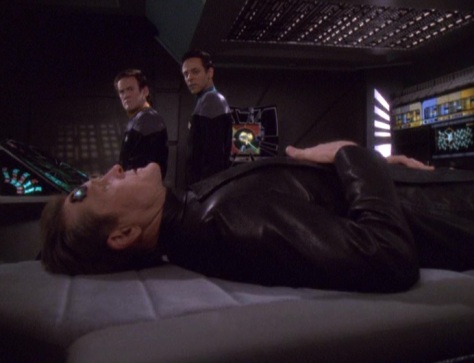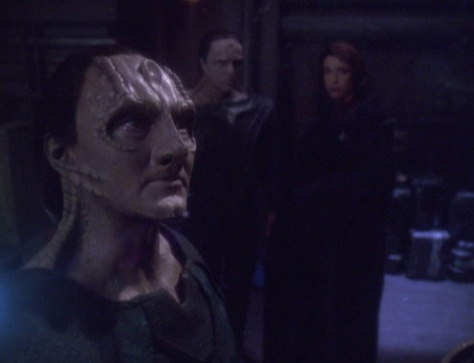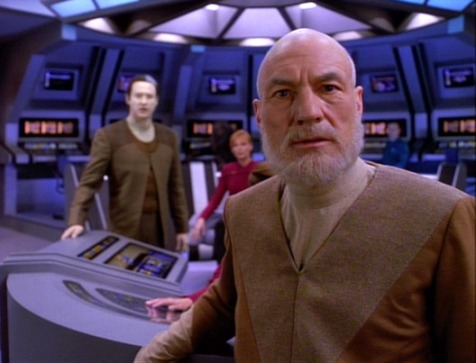
It’s suddenly six years later, Enterprise is returning to Earth for a big summit setting up an alliance of planets (didn’t that just happen?) and Archer’s going to give a speech (that definitely just happened). Then, Will Riker says “freeze program” and it turns out he’s in the holodeck on the Enterprise-D, and it’s REALLY 2370. Riker’s using a historical holodeck program (at the suggestion of Deanna Troi) of the NX-01’s final mission to figure out what to do in a dilemma shown in “The Pegasus”. He resumes the program and Shran shows up asking Archer for a favor. The mechanics of it aren’t that interesting, but Archer helps Shran out with some nasty bad guys, who later catch up with Enterprise. At gunpoint, Tucker essentially sacrifices himself to save Archer. Then, Riker (posing as Enterprise’s oft-mentioned Chef) talks to Tucker (presumably, earlier in the program) and gets a key insight about coming clean to Picard. Then, Riker and Troi watch as Archer is about to give his famous speech, and Riker calls for “end program.”
Why it’s important
For the second consecutive episode, I’m unclear as to what we see established as far as Earth’s alliance with other planets — but whatever it is, it’s important. Archer’s man-of-destiny role, which was such a big part of the series, comes to full fruition here.

What doesn’t hold up
Well, I hope you all have a few minutes.
First of all, let’s talk about the connection to “The Pegasus”. In that episode, Riker’s former captain (now an admiral) comes on board and orders Riker to continue helping with illegal experiments to build a Federation cloaking device. Riker can’t tell Picard because his old captain has him under orders. Riker eventually comes clean after seeing dead bodies on the titular (and previously assumed lost) vessel AND when use of the cloaking device will save the Enterprise-D from the Romulans. So, yes, Riker does the right thing, belatedly.
But if you watch this episode, you’d think Riker came around because his experience on the NX-01 helped him pick right from wrong — or that he was struck by Tucker’s loyalty to Archer. But that’s just not what happened.
Also, it’s odd that during the Enterprise-D’s mission, Riker would have so much time to spend on the holodeck. In the original episode, Riker actually spends time with Worf in another holodeck program (we see the after effects when Riker has to go to sickbay with a broken rib). Was Riker making Data pull all his shifts, or something? It’s not as if the Pegasus mission lasted more than a few days.
There’s also the matter of the decision to advance things on the NX-01 by six years.
Put simply, it was TERRIBLE that the main characters didn’t seem to have changed at all, other than hairstyles and uniforms. Sato and Mayweather were both STILL ensigns, for crying out loud! And apparently Tucker and T’Pol never did get together, which really makes all the third and fourth season stuff seem not just trivial but pointless. Honestly, based on the character development we see here — other than what happened to Shran — nothing interesting would have occurred on Enterprise (character-wise) for SIX MORE YEARS. Maybe the series needed to be canceled if the creators were so lacking in ideas. You could argue that the creators didn’t have enough time to show any Enterprise character developments. Of course, if they hadn’t devoted half the episode to Riker and Troi …
Then, there’s the matter of Starfleet wanting to decommission Enterprise. Consider that, 100 years later, we see Starfleet vessels in service for decades (Kirk’s first Enterprise was around, with refits, for 40 years!). Why would Starfleet — which had TWO warp-5 capable ships when the credits rolled in “Terra Prime” — want to moth ball a ship that still has to be relatively advanced?
Oh, and of course, Jonathan Frakes and Marina Sirtis looked about 10 years older than they did in “The Pegasus” … because they were 10 years older. The Enterprise-D sets mostly look good, though the observation lounge was off.
Before we move on, Tucker’s sacrifice — while noble — sure seemed odd. He survives for a few minutes while the bad guys who were farther away from the explosion died instantly? Also, why didn’t we see Reed or any MACOs in the area after the bad guys board the ship?
Lastly, the question has to be asked where Riker’s program came from. Was it some interpretation of the NX-01’s final mission? It’s hard to believe it could be 100 percent accurate, given the personal conversations and details. Hmmmm …

Final thoughts
Now, we get to the question about what the creators were thinking, and if it worked.
Generally, the answer is “no.” This episode doesn’t really serve as a finale for Enterprise. It’s really a finale to second-generation Trek. That wasn’t an awful idea and it was billed as a “Valentine” to the fans. But it’s too bad that Enterprise got short-changed. It almost feels like the creators sort of figured that Enterprise was a failed series and threw in a TNG connection to try to make everyone happy. The best moment was probably the final montage of the three Enterprises — but that could have been done even if the previous 43 minutes had been different.
Was Enterprise a failed series, though? Certainly, it got canceled. But the third season was quite daring and the fourth — while filled with too much fan service — was an improvement over seasons one and two and quite entertaining at times. As I’ve noted before, I’ll take daring and flawed over boring and flawed. That’s why I stand firm that Enterprise is a superior show to Voyager.
Big picture, Enterprise did feel like a series that never quite clicked, but it came close while dealing with a shifting dramatic TV landscape and general Trek fatigue. I would have enjoyed watching more seasons, but ratings are ratings, I guess.
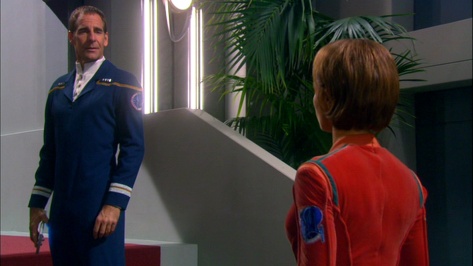
Coming next week …
We’ll be back with a few wrap-up articles, but this will be our final review — at least, for a while.

